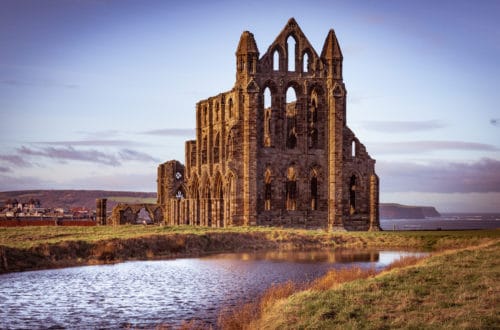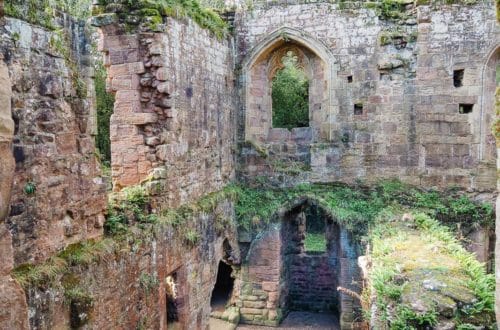
3 Must-See Abbeys in Yorkshire
Looking for cool historical sites to visit on your trip to Yorkshire? Abbey ruins in Yorkshire are some of the most popular places to visit to get a first-hand look at British history.
Contents
3 Must See Abbeys in North Yorkshire
Let’s look at three of the best Yorkshire abbeys and what makes them worth including in your travel itinerary.
Whitby Abbey
Set on high cliffs overlooking the sea, this abbey in North Yorkshire is considered a key landmark of English heritage. The stunning gothic ruins have inspired poets, writers, and artists – not to mention the countless tourists who pass through!
Founded around 657 as a monastery, then converted to a Benedictine abbey, Whitby has been monumental in shaping the role of the Church of England.
Beyond the history of the church, Whitby was also made famous by Bram Stoker, the author of Dracula. Upon visiting the town of Whitby, Stoker was so struck by the gothic architecture of the abbey that he decided to use it as a setting for his vampire novel.
If you feel up to the physical challenge, you can take the 199 steps up to the abbey from the town below. Count them as you go, and join the debate about whether the exact number is really 199!
Rievaulx Abbey Yorkshire
Rievaulx Abbey was northern England’s first Cistercian abbey and was founded in 1132. Much of what is seen today of the abbey was constructed during the time of Abbot Aelred’s rule, who is regarded as Rievaulx’s most famous abbot.

The abbey was shut down in 1538 as part of the Reformation under King Henry VIII. It remained mostly unused until the 1770s, at which point artists and writers began visiting the ruins for inspiration.
Today, the Rievaulx Abbey is protected as an important historic site of England.
When you visit, take the circular Rievaulx walk, which first goes through the abbey, then into the nearby Ashberry Wood for views of the abbey from a distance, then circles back around to the starting point.
Fountains Abbey
Fountains Abbey stands out among the other abbeys in Yorkshire thanks to the immense size of the ruins and the stunning water gardens surrounding the property. These gardens were created by John Aislabie and include beautiful ponds, lilies, and statues – all with the backdrop of the impressive abbey ruins.
This is also the largest abbey ruins in England: the entire Fountains Estate covers about 850 hectares of land.
A defining feature of the Fountains Abbey is that the abbey church is still mostly standing. You can enter the ruins to admire the over 300-foot long vaulted cellarium and magnificent stonework architecture of these exemplary Yorkshire abbey ruins.
Other Monasteries in Yorkshire
What is the difference between an abbey and a priory?
An abbey and a priory have some technical differences although the two terms are now used almost interchangeably. The primary difference is one of title: an abbey is under the care of an abbot or abbess, and a priory is organized by a prior or prioress. Both are great historical sites to visit while traveling in England.
Mount Grace Priory
Enjoying a peaceful and serene setting in North Yorkshire, Mount Grace Priory is composed of both the ruins of a medieval monastery and meticulously maintained gardens. Mount Grace is also considered England’s best-preserved Carthusian monastery.
The Mount Grace Priory gardens date back to when monks were in residence and would spend their time maintaining the gardens as part of their solitary lifestyle. Today, the gardens have been grown in accordance with how they would probably have looked in medieval times to provide guests an immersive historical experience.
If you feel up to a longer hike, you can take the Mount Grace Priory walk, a 3.25-mile looped trail running through the town of Osmotherley, the surrounding woodlands, and the priory itself.
Kirkham Priory
A beautiful example of medieval ruins in North Yorkshire, Kirkham Priory functioned as a community of Augustinian canons, or priests in communal residence. The strict lifestyle and timetables the canons followed played a role in the monastic reform of England during the 11th century.
Today, the ruins of Kirkham Priory are open to the public to tour the beautiful grounds and get a glimpse of what life would have been like for the priests in residence.
The priory is also famous for Winston Churchill’s secret visit during World War II to test the D-Day landing vehicles.
SPREAD THE WORD! PIN THIS TO YOUR TRAVEL PINTEREST BOARDS FOR FUTURE REFERENCE!
We did not receive compensation of any form, monetary or otherwise, from any of the products, services, hotels etc mentioned in this article.
This site generates income via partnerships with carefully-curated travel and lifestyle brands and/or purchases made through links to them at no extra cost to you. More information may be found on our Disclosure Policy.





